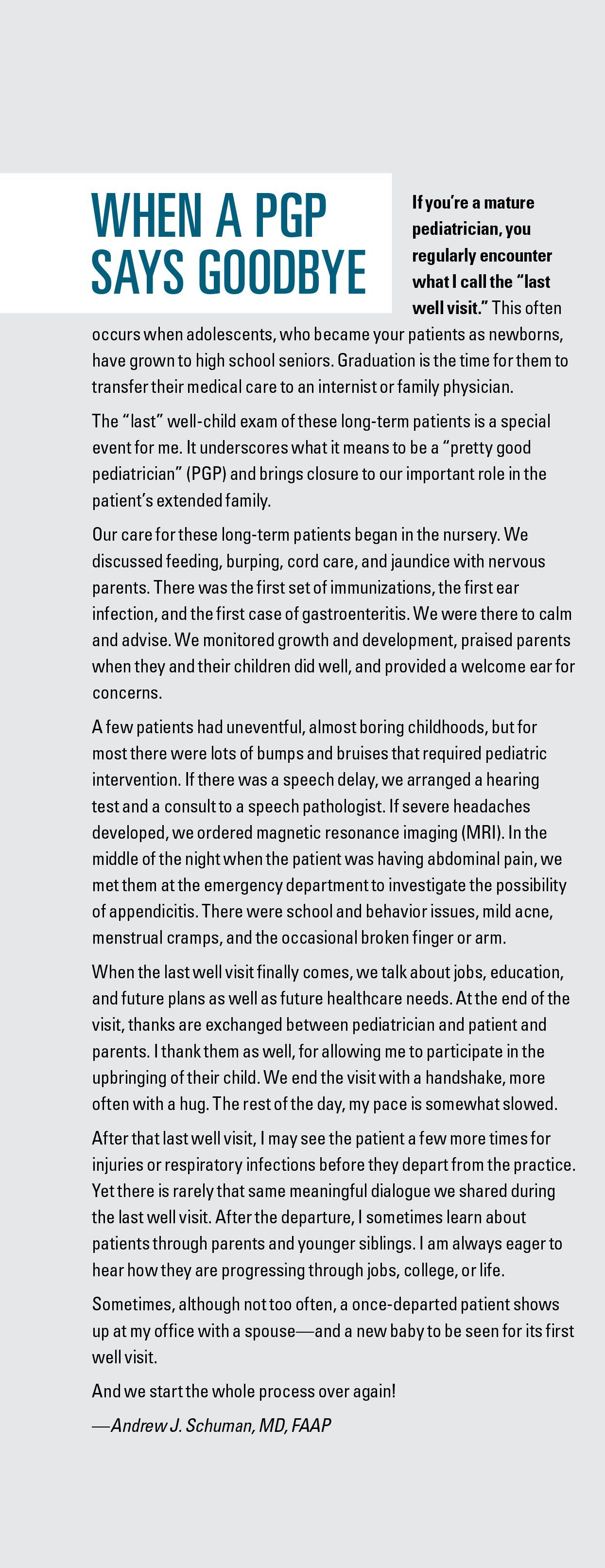How to get from PCP to “PGP”
Pediatricians who go above and beyond the expected in patient care can achieve the coveted status of “PGP”- pretty good pediatrician. Follow these 10 steps to achieve that special bond with your patients.
When a PGP says goodbye

Being a pediatrician for more than 30 years gives one a unique perspective on pediatric practice. Over the years I’ve accumulated advice worth passing on to the next generation of pediatric providers. Whereas medical care has grown ever more complicated and impersonal over my decades of practice, it’s still fun to go to work each day. When you arrive at the office each morning, you never know what challenges lie in wait, and every day is different than the day before.
That said, in my opinion, it is our relationship with patients and parents that is the most important aspect of quality pediatric care. Although we are identified by our patients and their insurance companies as a “primary care provider” (PCP), I think every pediatrician should strive to move beyond the impersonal PCP status and endeavor to upgrade to the coveted rank of “PGP”-that is, “pretty good pediatrician.”
Qualities of a PGP
Pediatricians bond with patients and parents over time, and this is why many families are devoted to their pediatrician. It is this bond that’s associated with a high level of trust that enables one to be a better provider. All parents are different, and the PGP has learned how to deal with a wide variety of parental attitudes and demeanors. The key is not to just talk about healthcare, but to talk to mothers and fathers as real people-briefly asking where they grew up, what jobs they do, and then ask them what they enjoy about being a parent and what is most challenging for them. It is important that pediatricians adopt an appropriate demeanor as well, never paternal, never threatening, but one akin to that of a longtime trusted friend.
At follow-up visits, I usually recall the “tidbit” parts of previous conversations I’ve had with parents or patients, and I use these to quickly break the ice. It is always nice for a patient to realize that we remember he likes baseball, or she received an award at a dance competition. I ask patients to bring in school report cards at follow-up visits, or a picture they drew that I can hang up in my office or exam room. Oh, yes, and never wear a white coat, and funny ties or scarfs are always helpful.
What PGPs can do for patients
A PGP will make the time to call or email the parent of a sick child a day or 2 following the visit just to check in and answer questions. The PGP has learned to make his or her practice super-efficient so there is time in the schedule to see the few patients that must be seen ASAP. This efficiency comes from becoming proficient at using electronic health records (EHRs), scheduling the workday appropriately, and staffing to the level of need. It comes from using appropriate technologies to speed documentation (voice dictation) as well as using technologies that expedite screening for vision, hearing, and development.
Perceptive PGPs also have a sense of when parents or patients need help getting necessary services, such as counseling for depression, or when a diagnostic study needs to be expedited. Engaging PGPs are familiar with the many assets in their community and call in favors from colleagues to facilitate and expedite patient services. Some PGP practices employ a full- or part-time social worker to provide these services. Concerned PGPs will call specialists to get opinions regarding assistance with diagnostic workups or expediting visits, often reducing wait time to days that would ordinarily take months.
From PCP to PGP: 10 easy steps
If you’d like to upgrade from ordinary PCP status to PGP, here are several ways to work toward this goal:
1. Whereas the PCP will often have staff return phone calls to patients, the PGP will often return calls personally to discuss lab or imaging results or just to check in on an ill child.
2. The PGP learned long ago that one of the best skills a pediatrician can have is to learn to listen and sense when a parent is concerned.
3. Although we are good listeners, the skilled PGP efficiently directs a patient interview and asks the fewest questions necessary to arrive at a diagnosis, yield treatment options, or suggest a workup.
4. The PGP will examine a patient while taking a history in order to expedite the visit and leave plenty of time to talk with patient and parent.
5. The PGP always treats the patient and parent as you would want to be treated yourself (aka “the Golden Rule of Pediatric Care”).
6. The PGP will always err on the side of caution. Although we want to limit the amount of money spent by patients, we consider appropriate diagnostic studies when indicated.
7. The PGP will always listen to suggestions made by elder pediatricians as they often provide very useful advice.
8. The PGP always make kids leave with a smile, by giving out stickers or safe age-appropriate parting gifts.
9. The PGP will never be afraid to use the phrase “I’m sorry” if you make a mistake, or “I don’t know” when faced with a diagnostic dilemma.
10. The PGP will read journals and attend conferences to stay up-to-date with current recommendations.
A final note
Good luck on your journey toward PGP status. For some this journey may take months, while for others it may take years. I assure you it is worth the effort. Unlike other endeavors in our profession, you will not receive a certificate of completion, but you will “know” when the goal has been achieved!

Anger hurts your team’s performance and health, and yours too
October 25th 2024Anger in health care affects both patients and professionals with rising violence and negative health outcomes, but understanding its triggers and applying de-escalation techniques can help manage this pervasive issue.